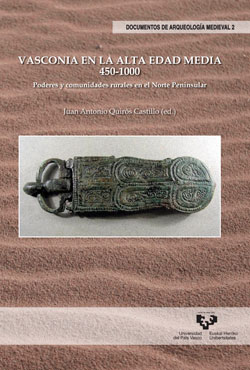Vasconia in the Early Midlle Ages, 450-1000. Powers and rural communities in the North of the Peninsula (2011).Abstract

This book is published by the Heritage and Cultural Landscapes Research Group of the Basque Country University, funded by the Basque Government in the framework of the research project «La formación de los paisajesmedievales en el Norte Peninsular y en Europa: Agricultura y ganadería los siglos V al XII» (HUM2009-07079), funded by the Ministry of Science and Innovation.
The objectives of this paper are two: on one hand, it expects to present an overview about our knowledge of the Basque territory among the 450-1000, having in mind the noticeable progresses that have taken part during the last ten years or so. The PhD of I. García Camino, the Santa Maria Cathedral project or the one about the deserted villages of Álava, have supposed the full integration into the historical debate of the archaeological register. On the other hand, since the PhD of J. J. Larrea and other current papers, there has been a deep renovation of the studies about this period, questioning determined historiographical clichés and bringing in new thematics.
On the other hand, after the publication of Chris Wickham's Framing the Early Medieval Ages (2005), it is evident that the analysis of this period demands an approach in comparative terms, which evaluate the processes and not individual cases, so in this book we expect to integrate the understanding of the basque early medieval society in relation with other spaces, promoting a new point of view.
The two thematic axes which articulate the papers gathered in this volume are the aristocracies and power forms in the Early Medieval Ages, and the social organization of the space from the villager's point of view.
The volume is divided into two parts. In the first one, there are collected the papers presented to the conference held in the Faculty of Arts of the University of the Basque Country in Vitoria-Gasteiz, on the 11st and 12th of March 2010. Besides these papers, the volume includes the transcription of the round table that closed the conference, as well as the conclusions made by Chris Wickham. In the second part of the book, centred into the archaeology of Vasconia in the Early Middle Ages, four territorial syntheses are presented, Navarra, La Rioja, Guipuzcoa and the Cantabrian Basque Country, and preliminary reportsof seven archaeological projects which analyse some of the main early medieval contexts of the basque area are presented.
